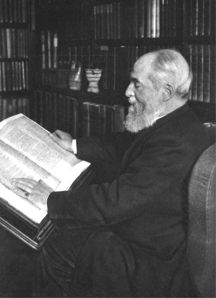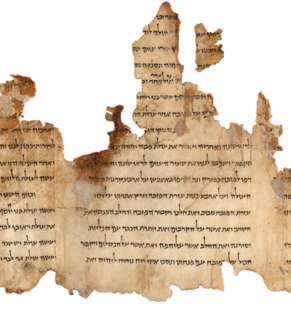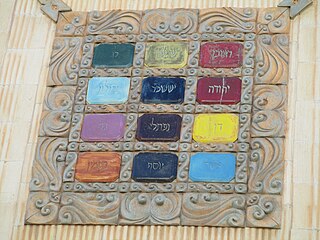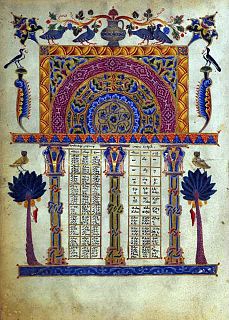The Syro-hexaplar version (also Syro-Hexapla) is the Syriac translation of the Septuagint based on the fifth column of Origen's Hexapla. The translation was made by Bishop Paul of Tella, around 617, from the Hexaplaric text of the Septuagint. [1] [2] A Palestinian Syriac version, extant in fragments, is known to go back to at least 700. [3]

Syriac, also known as Syriac/Syrian Aramaic or Classical Syriac, is a dialect of Middle Aramaic. Having first appeared in the early first century CE in Edessa, classical Syriac became a major literary language throughout the Middle East from the 4th to the 8th centuries, preserved in a large body of Syriac literature. Indeed, Syriac literature comprises roughly 90% of the extant Aramaic literature. Syriac was once spoken across much of the Near East as well as Anatolia and Eastern Arabia.

The Septuagint is the earliest extant Greek translation of the Hebrew scriptures from the original Hebrew. It is estimated that the first five books of the Old Testament, known as the Torah or Pentateuch, were translated in the mid-3rd century BCE and the remaining texts were translated in the 2nd century BCE. Considered the primary Greek translation of the Old Testament, it is quoted a number of times in the New Testament, particularly in the Pauline epistles, by the Apostolic Fathers, and later by the Greek Church Fathers.

Hexapla is the term for a critical edition of the Hebrew Bible in six versions, four of them translated into Greek, preserved only in fragments. It was an immense and complex word-for-word comparison of the original Hebrew Scriptures with the Greek Septuagint translation and with other Greek translations. The term especially and generally applies to the edition of the Old Testament compiled by the theologian and scholar Origen, sometime before the year 240 CE.
Contents
This version is important for the study of the Septuagint, for Swete believed that it often includes the symbols Origen used to mark the differences he observed between the Septuagint text and the Hebrew text. [4] Since many later copies of the Septuagint dropped Origen's symbols, the Syro-Hexapla is one of the primary ways that textual critics can identify hexaplaric material in the Septuagint. [5]

Henry Barclay Swete, FBA was an English Biblical scholar. He became Regius Professor of Divinity at Cambridge in 1890. He is known for his 1906 commentary on the Book of Revelation, and other works of exegesis.

Hebrew is a Northwest Semitic language native to Israel; the modern version of which is spoken by over 9 million people worldwide. Historically, it is regarded as the language of the Israelites and their ancestors, although the language was not referred to by the name Hebrew in the Tanakh. The earliest examples of written Paleo-Hebrew date from the 10th century BCE. Hebrew belongs to the West Semitic branch of the Afroasiatic language family. Hebrew is the only living Canaanite language left, and the only truly successful example of a revived dead language.

Textual criticism is a branch of textual scholarship, philology, and literary criticism that is concerned with the identification of textual variants in either manuscripts or printed books. Scribes can make alterations when copying manuscripts by hand. Given a manuscript copy, several or many copies, but not the original document, the textual critic might seek to reconstruct the original text as closely as possible. The same processes can be used to attempt to reconstruct intermediate versions, or recensions, of a document's transcription history. The objective of the textual critic's work is a better understanding of the creation and historical transmission of texts. This understanding may lead to the production of a "critical edition" containing a scholarly curated text.
Being a direct translation from the Greek of the Septuagint into Syriac, it should be distinguished from the Peshitta, which is a Syriac translation directly from the Hebrew.
Koine Greek, also known as Alexandrian dialect, common Attic, Hellenistic or Biblical Greek, was the common supra-regional form of Greek spoken and written during the Hellenistic period, the Roman Empire, and the early Byzantine Empire, or late antiquity. It evolved from the spread of Greek following the conquests of Alexander the Great in the fourth century BC, and served as the lingua franca of much of the Mediterranean region and the Middle East during the following centuries. It was based mainly on Attic and related Ionic speech forms, with various admixtures brought about through dialect levelling with other varieties.

The Peshitta is the standard version of the Bible for churches in the Syriac tradition.





